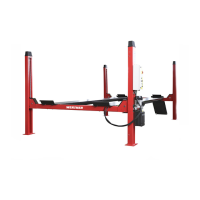
Do you have a question about the WERTHER INTERNATIONAL 442 LP and is the answer not in the manual?
| Brand | WERTHER INTERNATIONAL |
|---|---|
| Model | 442 LP |
| Category | Lifting Systems |
| Language | English |
Manual provides essential information for safe operation and maintenance of the lift.
Contact information for the manufacturer and authorized service centers.
Information on how the lift is packed, unit weights, and shipping methods.
Guidelines for safe lifting, handling, and storage of the lift packs.
Recommended storage environments and precautions for stacking packs.
Instructions for safely opening lift packaging and inspecting for damage.
Explains the manual's importance for personal, lift, and vehicle safety.
Lists European directives and standards the lift complies with.
Specifies operations must be performed by authorized, qualified personnel only.
Clarifies manufacturer liability and the need for operator experience to understand the manual.
Describes the four-post lift, its fixed and movable parts, and basic components.
Defines operator and danger zones around the lift for safe operation.
Details the fixed structure, including posts, safety rods, and cables.
Describes the components of the electrical control panel and hydraulic power unit.
Explains the movable cross-pieces, platforms, and their safety features.
Lists components located inside the fixed platform, such as the hydraulic cylinder.
Provides key specifications for lift capacity, dimensions, and clearances.
Details specifications for lifting cables, electric motor, and hydraulic pump.
Describes the hydraulic power unit and its function in converting motor motion to oil pressure.
Specifies the type of hydraulic oil required and its contamination category.
Illustrates the electrical connections for the lift's operation and safety systems.
Shows the schematic of the hydraulic circuit, illustrating component interconnections.
Provides a key for understanding wiring diagrams and a list of electrical components with part numbers.
Visual representation of cable routing and connections to electrical components.
Detailed diagram of the hydraulic circuit with numbered components and their descriptions.
Specifies the types of vehicles and their maximum dimensions suitable for lifting.
Information on maximum vehicle weights and how to check load and possible unbalance.
Crucial safety information regarding lift operation and maintenance risks.
Lists unauthorized uses of the lift and defines critical danger and operator zones.
Outlines general precautions for operators and maintenance personnel to prevent hazards.
Details safety devices and procedures to prevent vehicle movement along the lift's length.
Guidelines for ensuring safety during side movements and correct vehicle positioning.
Describes safety devices like relief valves and cylinder locking valves for overload and hose breaks.
Explains safety mechanisms for overstroke situations and cable slackening or breakage.
Warns about the risk of crushing the operator if not in the correct position at the control panel.
Advises against personnel being in the danger zone or under moving parts during descent.
Covers risks of impact, vehicle moving due to force, and vehicle falling from the lift.
Addresses risks associated with slack lift cables and improper use like driving on platforms.
Highlights risks of slipping on contaminated floors and electric shock hazards.
Discusses risks from inadequate lighting, component failure, and improper usage.
Details requirements for the installation location, including clearances and environmental factors.
Specifies necessary lighting levels and floor characteristics for safe installation.
Shows an example of industrial floor thickness and preparation methods.
Provides precise measurements and tolerances for marking column positions on the floor.
Strictly prohibits unauthorized persons from participating in assembly operations.
Step-by-step instructions for assembling the movable structure, including platforms and trestles.
Instructions for removing safety rods and preparing the control post for component mounting.
Details the process of connecting the hydraulic system, including hoses and fittings.
Guides on fitting safety rods and preparing cable sensors for correct positioning.
Specific steps for connecting hydraulic hoses, unions, and breather pipes.
Essential checks before electrical connection, including power supply protection.
Instructions for connecting limit switches, solenoid valves, and the motor, including voltage selection.
Critical checks before operating the lift, including oil level, motor rotation, and wedge function.
Steps for pre-adjusting lift cables for platform leveling and adjusting cable sensors.
Instructions for adjusting post shoes and ensuring posts are perfectly perpendicular to the floor.
Details the process of drilling and anchoring posts to the floor using specific hardware.
Guides on fitting vehicle ramps and wheel stops to the platforms as required.
Procedures for adjusting lifting cables and checking U-bolt tightening for proper lift leveling.
Comprehensive checks of mechanical and electrical systems before initial lift operation.
Verifies hydraulic system, motor rotation, and performs initial set-up procedures.
Explains the function of each control button and the main switch positions.
Step-by-step guide for lifting the vehicle and the automatic stopping mechanism.
Details the lowering process, including safety mechanisms and audible alarms.
Emphasizes that maintenance must be done by expert personnel and includes safety warnings.
Highlights risks during maintenance and provides essential tips for optimal upkeep.
Outlines essential checks and lubrication tasks to be performed monthly.
Lists tasks for 3-monthly checks, including anchor bolts, lift cables, and hydraulic pump.
Details tasks for 6-monthly oil checks and 12-monthly general, electrical, and hydraulic system inspections.
Guidelines for cleaning and maintaining painted surfaces to ensure longevity and prevent corrosion.
Provides a guide for diagnosing and resolving common lift issues, emphasizing safety compliance.
Lists common lift malfunctions, their causes, and recommended solutions for repair.
Information on the proper disposal of used oil and procedures for scrapping the machine.
Information on available spare parts and the procedure for ordering them.
